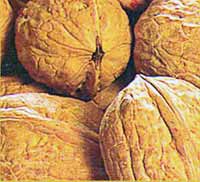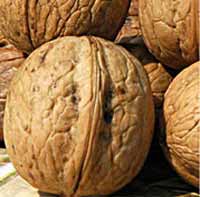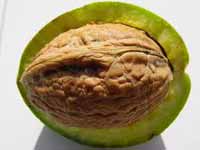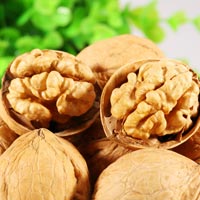WALNUT SEEDLINGS
or
WALNUT FRUIT TREE PLANT
Walnut seedlings are one of the most widespread types of fruit.
Walnut is a tree 10 to 40m high, with pointed leaves 20 to 30cm long.
In Europe, walnut is most grown in France, Italy and Greece. In Serbia, it is grown in all parts of the country. It is mostly grown in river valleys.
The fruits of all kinds of walnuts are edible.
The importance of walnut growing
The importance of growing walnuts is primarily due to the kernel. Walnut kernel is one of the most important charcoal-protein products. It contains about 57-60% fat and 15-18% protein. The kernel energy value is about 2500 kJ. Walnut also contains vitamins A, B, C and E. Walnuts have a lot of oil and are eaten raw or cooked. They are also a great source of omega-3 fatty acids, and have proven to be excellent at lowering cholesterol.
The importance of walnuts is reflected in the great technical value of wood, the industrial use of walnut oil, the variety of bark and leaves used (for fabric colors and more ...), the ability to easily transport and store fruit.
The climate for walnut growing
Walnut thrives in favorable climatic conditions, without strong winter frosts, on deep and loose soils with sufficient lime, then on alluvial, loamy-sandy and skeletal soils. Some of them also develop on rocky lands. In Serbia it is most commonly grown in river valleys. Walnut usually thrives where oak grows. Moderately warm areas are most suitable for it. All walnut life functions require a lot of heat and plenty of water.
Soil
It grows on soils of different physical and chemical properties, provided they are not too shallow, heavy and impermeable. Two features of the soil are significant: 1) to have a good damping regimen 2) to be loose enough. Research in California has shown that walnut is also successfully grown on acidic, neutral and slightly alkaline soils with a pH of 5,5-8,0.
Walnut quality assessment
Kernel weight per fruit - It is important for evaluating the value of walnuts. The kernel weight for commercial walnut ranges from 5 to 8 grams.
Kernel color - An important feature in determining the sales value of a walnut. The advantage is given to brighter colors. The color of the kernel may be varietal or reflect poor harvesting, processing and storage.
Shell color - Light or dark, the color of the fruit depends on manipulation and some other measures, as well as on the protection carried out against insects and diseases. Damage caused by insects and diseases, exposure to rain or leaving the fruit lying on the ground badly affects the shell color.
More on Wikipedia.
Seedlings of WALNUT – DOMESTIC WALNUT:
 Description:
Description:
These seedlings are of domestic origin.
Domestic walnut has a solid yield. The fruit is medium-sized, with a soft shell and a light kernel.
Ripening time: Beginning of September
Rootstock: Its own root.
Seedlings of WALNUT - CHAMPION:
 Description:
Description:
The Champion seedlings are of domestic origin.
The Champion walnut is a lush and very fruitful variety. It is resistant to disease.
The weight of the fruit is about 14 grams, the kernel is light in color and contains 67% oil. The kernel fulfills about 58% of the fruit.
It ripens very early. Excellent, medium lush and fruitful variety. It can be grown in all areas suitable for fruit.
Ripening time: Beginning of September
Rootstock: Its own root.
 The Geisenheim seedlings are originally from Germany. The tree is medium blush and fruitful. It enters the vegetation period late and ends it early, so frosts do not endanger it. It partially forms apomictic fruits. The shell is very smooth, light and beautiful. The kernel is of good taste and yellowish.
The Geisenheim seedlings are originally from Germany. The tree is medium blush and fruitful. It enters the vegetation period late and ends it early, so frosts do not endanger it. It partially forms apomictic fruits. The shell is very smooth, light and beautiful. The kernel is of good taste and yellowish.
The fruit is medium-sized to large, with an average weight of about 13 grams. It is round-ovate-shaped, has bright and easily brittle shells. The kernel fulfills about 48% of the fruit.
Ripening time: Beginning of October
Rootstock: Its own root.
Seedlings of WALNUT - PUREBRED:
 These seedlings are a selection of the Faculty of Agriculture in Novi Sad, selected from the spontaneous walnut population.
These seedlings are a selection of the Faculty of Agriculture in Novi Sad, selected from the spontaneous walnut population.
The tree is less lush and fruitful. Becomes fruitful very early, as a seedling in a nursery. It enters the vegetation mid-late.
The fruit is medium-sized, with an average weight of about 12 grams. It is roundish-domed. The shell of the fruit is soft and easily brittle. The kernel fulfills about 50% of the fruit.
These seedlings are suitable for cultivation in continental (non-vineyard) zones.
Ripening time: Mid-October
Seedlings of WALNUT – BULGARIAN SHEYNOVO:
 The Bulgarian Sheynovo seedlings are originally from Bulgaria, just like their name suggests.
The Bulgarian Sheynovo seedlings are originally from Bulgaria, just like their name suggests.
Sheynovo is one of the best walnut seedlings. It starts vegetation late and is resistant to frost.
It is a medium lush and very fruitful variety. Plentifully and regularly fruitful. The vegetation period enters somewhat earlier than it would be desirable. Fruit – medium-sized, weighing about 12 grams. It is ovate-shaped, of a thin and easily brittle shell. The kernel fulfills about 53% of the fruit. The kernel is of good quality, but because of its darker color it is not attractive.
Ripening time: Beginning of September
Rootstock: Its own root.
Seedlings of WALNUT - CHANDLER:
 The Chandler seedling is originally from the US.
The Chandler seedling is originally from the US.
Chandler is both the best selling and most fruitful walnut variety. In recent years, it has proven to be the most economical variety for new orchards because of its productivity and excellent kernel quality. Chandler produces large kernels of very light color. Kernel color is an important feature in determining the selling price of a walnut. Walnuts that have a lighter kernel color are more priced.
Kernels are easily removed from the thin and smooth shell. They taste good, can be consumed fresh as well as dried, the oil content is at least 50% and the protein 20%.
Chandler is a self-pollinating variety of walnuts, it can produce fruit without pollinators, but can be more fruitful when used with them. The Franquette variety is used as a pollinator with Chandler trees.
Ripening time: Mid-September
Rootstock: Domestic walnut
Walnut Seedlings - Some facts about walnuts:
- Walnut seedlings grow into a tree that can be 12 to 20 meters high and develop a crown of the same size
- Walnut bark is smooth and greenish-brown when the tree is young. It becomes gray and covered with cracks as the tree grows old.
- Walnut has leaves that consist of 5 to 9 alternately arranged feathers.
- Walnut tree has a strong and deep root. It produces chemicals (called juglones) that prevent other plants from growing close to the tree.
- Walnut tree produces fruit in a shell covered with a green membrane.
- The Greek word for walnut (“kernel”) also means "head". The name derives from the fact that the walnut shell looks like a skull protecting the brain kernels beneath it.
- Due to the high amount of oil in the kernel, the walnut becomes rancid after exposure to atmospheric oxygen. The brown shell lays off this effect and keeps the seeds fresh and delicious.
